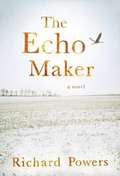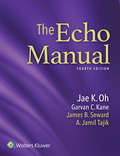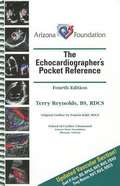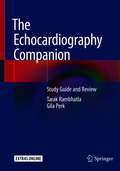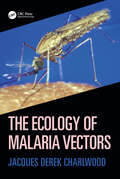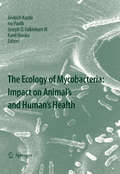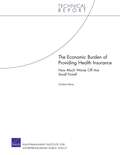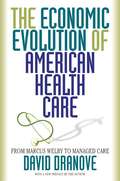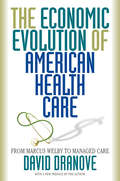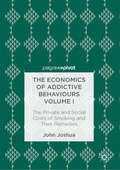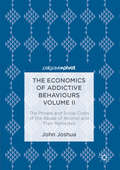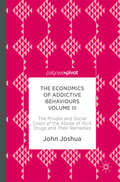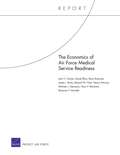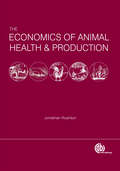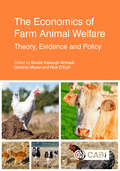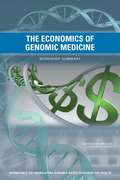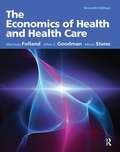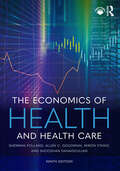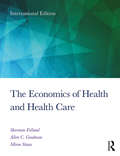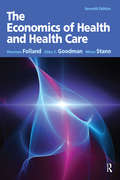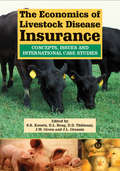- Table View
- List View
The Echo Maker
by Richard PowersOn a winter night on a remote Nebraska road, 27-year-old Mark Schluter flips his truck in a near-fatal accident. His older sister Karin, his only near kin, returns reluctantly to their hometown to nurse Mark back from a traumatic head injury. But when he emerges from a protracted coma, Mark believes that this woman–who looks, acts, and sounds just like his sister–is really an identical impostor. Shattered by her brother's refusal to recognize her, Karin contacts the cognitive neurologist Gerald Weber, famous for his case histories describing the infinitely bizarre worlds of brain disorder. Weber recognizes Mark as a rare case of Capgras Syndrome, a doubling delusion, and eagerly investigates. What he discovers in Mark slowly undermines even his own sense of being. Meanwhile, Mark, armed only with a note left by an anonymous witness, attempts to learn what happened the night of his inexplicable accident. The truth of that evening will change the lives of all three beyond recognition.<P><P> Set against the Platte River's massive spring migrations–one of the greatest spectacles in nature–The Echo Maker is a gripping mystery that explores the improvised human self and the even more precarious brain that splits us from and joins us to the rest of creation.<P> The Echo Maker is the winner of the 2006 National Book Award for Fiction.
The Echo Manual: Ebook without Multimedia
by Jae K. Oh Garvan C. KanePublisher's Note: Products purchased from 3rd Party sellers are not guaranteed by the Publisher for quality, authenticity, or access to any online entitlements included with the product. Ideal for residents, fellows, and others who need a comprehensive, clinically focused understanding of echocardiography, The Echo Manual, 4th Edition, has been thoroughly revised with updated information, new chapters, and new video clips online. Written primarily by expert authorities from the Mayo Clinic, this best-selling reference remains a practical guide to the performance, interpretation, and clinical applications of today’s echocardiography.
The Echocardiographer's Pocket Reference
by Terry Reynolds Pamela KiddI would first wish to express my deep gratitude to each of you for your continued support of this book. The fourth edition provides the newest American Society of Echocardiography recommendations for valvular stenosis
The Echocardiography Companion: Study Guide and Review
by Gila Perk Tarak RambhatlaThis is a comprehensive yet easy to read study guide for those preparing for the echocardiography board examinations, which brings all of the critical resources together into one convenient and portable resource. Echocardiography is an integral part of routine cardiology practice and this book represents a quick, yet thorough, reference that can be easily consulted to help practicing clinicians deliver high quality care to their patients. The Echocardiography Companion: Study Guide and Review includes a comprehensive educationally-focused review of the technique, its clinical uses, applications, and utilization in all cardiac conditions. The practical and quick reference format allows it to serve as a reference book and as a helpful companion to students, on which notes can be taken while studying from other resources such as board review videos.
The Ecology of Animal Senses
by Gerhard von der Emde Eric WarrantThe collection of chapters in this book present the concept of matched filters: response characteristics "matching" the characteristics of crucially important sensory inputs, which allows detection of vital sensory stimuli while sensory inputs not necessary for the survival of the animal tend to be filtered out, or sacrificed. The individual contributions discuss that the evolution of sensing systems resulted from the necessity to achieve the most efficient sensing of vital information at the lowest possible energetic cost. Matched filters are found in all senses including vision, hearing, olfaction, mechanoreception, magnetoreception and infrared sensing and different cases will be referred to in detail.
The Ecology of Malaria Vectors
by Jacques CharlwoodThis practical book covers all aspects of the biology of malaria vectors, with notes on the vectors of dengue. It is the first work in this field to concentrate on mosquitoes, rather than covering all disease vectors. Authored by renowned field entomologist Jacques Derek Charlwood, it disseminates his vast experience working on mosquito biology, ecology and the evaluation of new vector control tools across five continents over the past 40 years. Covering all aspects from classification and systematics, population dynamics, vector control, to surveillance and sampling, epidemics, and a selection of case histories, the book also considers genetics and resistance, Aedes biology, and malaria and dengue models. It is designed to fill the gap between very specialized texts and undergraduate books on general disease vectors, and is ideal as a textbook for postgraduate courses in entomology and mosquito vectors of disease.
The Ecology of Mycobacteria: Impact on Animal's and Human's Health
by Jindrich Kazda Joseph O. Falkinham III Karel Hruska Ivo PavlikThe Ecology of Mycobacteria principally emphasizes the ecological characteristics of the environmental mycobacteria. It is now well understood that the incidence and prevalence of potentially pathogenic mycobacteria is increasing in humans and animals. Further, proof that mycobacteria are normal inhabitants of drinking water distribution systems and household water systems, indicates that humans and animals are surrounded by mycobacteria and thus at risk. It is anticipated that the emphasis on ecology and routes of infection will result in a text of widespread use for clinicians and for research scientists in medicine, academia, and industry. In addition to identifying habitats and thereby sources of mycobacteria infecting humans and animals, the text identifies those mycobacterial characteristics that determine its range of habitats. Additionally, the text comments critically on the available methods to identify those protocols with values in mycobacterial research. In that manner, although there are no chapters specifically devoted to methods, superior methods for mycobacteria will be identified.
The Ecology of Purposeful Living Across the Lifespan: Developmental, Educational, and Social Perspectives
by Patrick L. Hill Anthony L. BurrowThis book explores what it means to live a purposeful life and outlines the benefits associated with purpose across different life domains. It also demonstrates that purpose in life is not reducible to constructs such as happiness, well-being, or identity development.The importance of having a sense of purpose in life is attracting renewed attention in both scientific and social arenas. Mounting evidence from intricately designed experiments and large-scale studies reveals how pursuing a purpose can make a person happier, healthier, and even lengthen their lifespan. However, existing texts on purpose have said little on why having has these effects, how it may influence our ability to navigate diverse environments, or how best to consider the construct from a multidisciplinary approach that moves beyond psychology.Recognizing this gap in the literature, this book provides multidisciplinary perspectives on the topic of purpose, and examines what we can do as researchers, interventionists, and society as a whole to imbue purposefulness in the lives of people across the lifespan. It includes contributions from key figures on topics such as identity, health, youth programs and youth purpose, diversity, aging and work.
The Economic Burden of Providing Health Insurance
by Christine EibnerMore than 60 percent of nonelderly Americans receive health-insurance (HI) coverage through employers. However, rising health-care costs may threaten the long-term viability of the employer-based insurance system. This report explores trends in the economic burden associated with HI provision for small and large businesses, as well as the quality of plans that small and large firms offer.
The Economic Evolution of American Health Care
by David DranoveThe American health care industry has undergone such dizzying transformations since the 1960s that many patients have lost confidence in a system they find too impersonal and ineffectual. Is their distrust justified and can confidence be restored? David Dranove, a leading health care economist, tackles these and other key questions in the first major economic and historical investigation of the field. Focusing on the doctor-patient relationship, he begins with the era of the independently practicing physician- epitomized by Marcus Welby, the beloved father figure/doctor in the 1960s television show of the same name-w ho disappeared with the growth of managed care. Dranove guides consumers in understanding the rapid developments of the health care industry and offers timely policy recommendations for reforming managed care as well as advice for patients making health care decisions. The book covers everything from start-up troubles with the first managed care organizations to attempts at government regulation to the mergers and quality control issues facing MCOs today. It also reflects on how difficult it is for patients to shop for medical care. Up until the 1970s, patients looked to autonomous physicians for recommendation- a process that relied more on the patient's trust of the physician than on facts, and resulted in skyrocketing medical costs. Newly emerging MCOs have tried to solve the shopping problem by tracking the performance of care providers while obtaining discounts for their clients. Many observers accuse MCOs of caring more about cost than quality, and argue for government regulation. Dranove, however, believes that market forces can eventually achieve quality care and cost control. But first, MCOs must improve their ways of measuring provider performance, medical records must be made more complete and accessible (a task that need not compromise patient confidentiality), and patients must be willing to seek and act on information about the best care available. Dranove argues that patients can regain confidence in the medical system, and even come to trust MCOs, but they will need to rely on both their individual doctors and their own consumer awareness.
The Economic Evolution of American Health Care: From Marcus Welby to Managed Care
by David DranoveThe American health care industry has undergone such dizzying transformations since the 1960s that many patients have lost confidence in a system they find too impersonal and ineffectual. Is their distrust justified and can confidence be restored? David Dranove, a leading health care economist, tackles these and other key questions in the first major economic and historical investigation of the field. Focusing on the doctor-patient relationship, he begins with the era of the independently practicing physician--epitomized by Marcus Welby, the beloved father figure/doctor in the 1960s television show of the same name--who disappeared with the growth of managed care. Dranove guides consumers in understanding the rapid developments of the health care industry and offers timely policy recommendations for reforming managed care as well as advice for patients making health care decisions. The book covers everything from start-up troubles with the first managed care organizations to attempts at government regulation to the mergers and quality control issues facing MCOs today. It also reflects on how difficult it is for patients to shop for medical care. Up until the 1970s, patients looked to autonomous physicians for recommendations on procedures and hospitals--a process that relied more on the patient's trust of the physician than on facts, and resulted in skyrocketing medical costs. Newly emerging MCOs have tried to solve the shopping problem by tracking the performance of care providers while obtaining discounts for their clients. Many observers accuse MCOs of caring more about cost than quality, and argue for government regulation. Dranove, however, believes that market forces can eventually achieve quality care and cost control. But first, MCOs must improve their ways of measuring provider performance, medical records must be made more complete and accessible (a task that need not compromise patient confidentiality), and patients must be willing to seek and act on information about the best care available. Dranove argues that patients can regain confidence in the medical system, and even come to trust MCOs, but they will need to rely on both their individual doctors and their own consumer awareness.
The Economics of Addictive Behaviours Volume I
by John JoshuaThis title discusses the phenomenon of smoking as a behavioural disease and the associated costs. The author details the consequences of smoking, in addition to the detrimental effects caused by second-hand tobacco smoke exposure as a health risk to children as well as to the general public. The central contribution of Joshua's work is to address these concerns in terms of the issues of free choice and the market. Considering the various restrictive policies designed to reduce smoking's prevalence, including the banning of smoking in public places, and the inclusion of warning labels on cigarette packets, Joshua carefully analyses potential economic remedies to the problem of smoking, notably the Pigovian tax. Finally, the book concludes with a highly relevant discussion of corporate social responsibility, and the role that this might play in anti-smoking projects. This is the first title in a four volume series 'The Economics of Addictive Behaviours', which consists of three further volumes on alcohol abuse, illicit drug abuse and overeating.
The Economics of Addictive Behaviours Volume II
by John JoshuaThis title discusses the phenomenon of alcohol abuse as a behavioural disease and the associated costs. The author details alcohol's status as a psychoactive drug; he notes, however, that in contrast to other psychoactive drugs, alcohol has been widely culturally accepted in Western countries and legally available, except in isolated incidents for a short period of time. Joshua considers which policies are being correctly utilised so as to reduce the abuse of alcohol, and how these policies may operate on a supply and demand model. Whereas programs of prevention and treatment operate on the demand side of alcohol abuse, legislation is directed at the supply side of alcohol; that is, dealing with marketing - product, promotion, point of sales and price. This is the second title in a four volume series 'The Economics of Addictive Behaviours', consisting of three additional volumes on smoking, illicit drug abuse and overeating.
The Economics of Addictive Behaviours Volume III
by John JoshuaThis title offers an in-depth analysis of the causes, consequences and treatments of illicit drug abuse. The author examines the effects of existing drug policies and proposes drug use legalisation within a regulated market as a viable alternative. Joshua assesses the factors that make individuals vulnerable to drug abuse and the pathways they may follow. As well as exploring the physical and psychological effects on the individual, Joshua examines the social and economic consequences for society. He highlights the pitfalls of a purely legal approach to drug abuse, which is primarily a health matter, and questions whether special drugs courts could be used as an alternative to the present criminal justice system. This book adds to the debate on whether most drugs could be sold in a regulated market in the same way as other drugs are, such as alcohol or nicotine. This is the third title in a four volume series 'The Economics of Addictive Behaviours', consisting of three additional volumes on smoking, alcohol abuse and overeating.
The Economics of Air Force Medical Service Readiness
by Daniel Blum James J. Burks Edward W. Chan John C. Graser Kevin BrancatoThe Air Force Medical Service (AFMS) currently runs three in-theater hospitals for severely injured or wounded personnel. Part of the practioners' preparation was treating DoD beneficiaries for a broad range of injuries and illnesses. Opportunities for this preparation are not as numerous "in house" as they once were, and AFMS does not always get proper credit for those gained elsewhere. Proper credit for that work is important for funding.
The Economics of Animal Health and Production
by Jonathan RushtonThis book draws on both extensive literature and experience in animal health economics and livestock issues in Europe, Asia, Africa and Latin America. It provides comprehensive coverage of the history of livestock and animal health economics, theory and tools for the economics of animal health and production, a review of the application of economics to animal diseases and health problems, and worldwide examples of economic analysis and policy making.
The Economics of Epidemiology
by Troy TassierThe book presents a basic introduction to epidemiology from the perspective of economics, using economic modeling to better understand and describe how infectious disease spreads. Three main elements are introduced: epidemiology, social network analysis, and the economics needed to model the behavior of individuals in the presence of infectious disease. The book aims to provide a starting point for discussion between medical professionals, social scientists and public health officials, the three groups interested in the spread of disease.
The Economics of Farm Animal Welfare: Theory, Evidence and Policy
by Richard Bennett David Harvey Beth Clark Donald Broom Anne-Marie Neeteson Bettina Bock César Revoredo-Giha Alistair Lawrence Faical Akaichi Jean-Luc Angot Dr Santiago Avendaño Carmen Hubbard Alfons Koerhuis Carolina Maciel Jarkko K Niemi Alistair Stott Belinda VigorsThis landmark new text charts the latest developments in economic research relevant to farm animal welfare. A range of global experts and key opinion leaders outline the challenges in achieving sustainable livestock production while improving farm profit, climate change and animal welfare, and make policy-relevant recommendations for the future. This is a theoretical yet practical book that examines: - the origins of farm animal welfare, cross-disciplinary interactions and the future of the field; - consumer demand and changing preferences as animal welfare rises up the social agenda; - the impact political organisations such as the EU and WTO have on animal welfare. An important resource for policy makers and animal welfare scientists, economists and clinicians, this book provides a thought-provoking yet evidence-based review for all those interested in quantifying and improving farm animal welfare.
The Economics of Genomic Medicine
by Institute of Medicine Steve Olson Board on Health Sciences Policy Adam C. Berger Roundtable on Translating Genomic-Based Research for HealthThe sequencing of the human genome and the identification of links between specific genetic variants and diseases have led to tremendous excitement over the potential of genomics to direct patient treatment toward more effective or less harmful interventions. Still, the use of whole genome sequencing challenges the traditional model of medical care where a test is ordered only when there is a clear indication for its use and a path for downstream clinical action is known. This has created a tension between experts who contend that using this information is premature and those who believe that having such information will empower health care providers and patients to make proactive decisions regarding lifestyle and treatment options. In addition, some stakeholders are concerned that genomic technologies will add costs to the health care system without providing commensurate benefits, and others think that health care costs could be reduced by identifying unnecessary or ineffective treatments. Economic models are frequently used to anticipate the costs and benefits of new health care technologies, policies, and regulations. Economic studies also have been used to examine much more specific issues, such as comparing the outcomes and cost effectiveness of two different drug treatments for the same condition. These kinds of analyses offer more than just predictions of future health care costs. They provide information that is valuable when implementing and using new technologies. Unfortunately, however, these economic assessments are often limited by a lack of data on which to base the examination. This particularly affects health economics, which includes many factors for which current methods are inadequate for assessing, such as personal utility, social utility, and patient preference. To understand better the health economic issues that may arise in the course of integrating genomic data into health care, the Roundtable on Translating Genomic-Based Research for Health hosted a workshop in Washington, DC, on July 17-18, 2012, that brought together economists, regulators, payers, biomedical researchers, patients, providers, and other stakeholders to discuss the many factors that may influence this implementation. The workshop was one of a series that the roundtable has held on this topic, but it was the first focused specifically on economic issues. The Economics of Genomic Medicine summarizes this workshop.
The Economics of Health Reconsidered (Third Edition)
by Lynn Unruh Thomas RiceThis book reconsiders the field of health economics as it is traditionally taught and practiced. It critically examines economic theory as applied to the health sector and questions the prevailing belief that a competitive healthcare marketplace results in the best outcomes. New information, including an overview of standard microeconomic theory, makes this new edition an ideal stand-alone text for health economics and health policy courses.
The Economics of Health and Health Care (Seventh Edition)
by Sherman Folland Allen C. Goodman Miron StanoA text that covers core economic themes as they relate to health care.
The Economics of Health and Health Care: International Student Edition, 8th Edition
by Sherman Folland Allen C. Goodman Miron Stano Shooshan DanagoulianThe Economics of Health and Health Care is the market-leading health economics textbook, providing comprehensive coverage of all the key topics, and balancing economic theory, empirical evidence, and public policy. The ninth edition offers updated material throughout, including two new chapters: Disparities in Health and Health Care (Chapter 7) examines issues of race, ethnicity, income, gender, and geography with respect to health care access, health inputs, and health outcomes; Pandemic Economics (Chapter 9) introduces a new and simplified economic treatment of epidemics and pandemics within the context of COVID-19. We also include applications from the growing literature on digital medicine. The book further highlights the impacts of the Affordable Care Act (ACA) and updates its path-breaking comparative analyses across countries to focus on the differences in access and costs. The book continues to provide a clear, step-by-step understanding of health economics, making economic principles accessible to students, supported by boxed examples, figures and tables. Each chapter contains concise summaries, discussion questions, and quantitative exercises to promote student learning. There is also a glossary of key terms and an extensive reference list. Instructors are supported by a range of digital supplements. It is the perfect textbook for students and practitioners taking undergraduate and postgraduate courses in health economics, health policy, and public health.
The Economics of Health and Health Care: International Student Edition, 8th Edition
by Sherman Folland Miron Stano Allen Charles GoodmanFolland, Goodman, and Stano’s bestselling The Economics of Health and Health Care text offers the market-leading overview of all aspects of Health Economics, teaching through core economic themes, rather than concepts unique to the health care economy. The Eighth Edition of this key textbook has been revised and updated throughout, and reflects changes since the implementation of the Affordable Care Act (ACA). In addition to its revised treatment of health insurance, the text also introduces the key literature on social capital as it applies to individual and public health, as well as looking at public health initiatives relating to population health and economic equity, and comparing numerous policies across Western countries, China, and the developing world. It provides up-to-date discussions on current issues, as well as a comprehensive bibliography with over 1,100 references. Extra material and teaching resources are now also available through the brand new companion website, which provides full sets of discussion questions, exercises, presentation slides, and a test bank. This book demonstrates the multiplicity of ways in which economists analyze the health care system, and is suitable for courses in Health Economics, Health Policy/Systems, or Public Health, taken by health services students or practitioners.
The Economics of Health and Health Care: Pearson New International Edition
by Sherman Folland Miron Stano Allen Charles GoodmanFor courses in Health Economics, U.S. Health Policy/Systems, or Public Health, taken by health services students or practitioners, the text makes economic concepts the backbone of its health care coverage. Folland, Goodman and Stano's book is the bestselling Health Care Economics text that teaches through core economic themes, rather than concepts unique to the health care economy. This edition contains revised and updated data tables, where applicable. The advent of the Patient Protection and Affordable Care Act (PPACA) in 2010 has also led to changes in many chapters , most notably in the organization and focus of Chapter 16.
The Economics of Livestock Disease Insurance: Concepts, Issues and International Case Studies
by Stephen R. Koontz J. L. Grannis D. L. Hoag D. D. Thilmany J. W. GreeneThe collection of studies emerged from two conferences. One in Fort Collins, Colorado in November 2002 invited professionals from countries where livestock disease insurance is common to share their experience on the matter with American insurance professionals. The other, in July 2003 in Denver, focused primarily on the US. The information is intended to be useful primarily to government agents, the insurance industry, and academics in agricultural economics. The 20 papers explore how to build a livestock insurance program, look at the international marketplace, and present case studies. Annotation ©2006 Book News, Inc., Portland, OR (book news. com)
